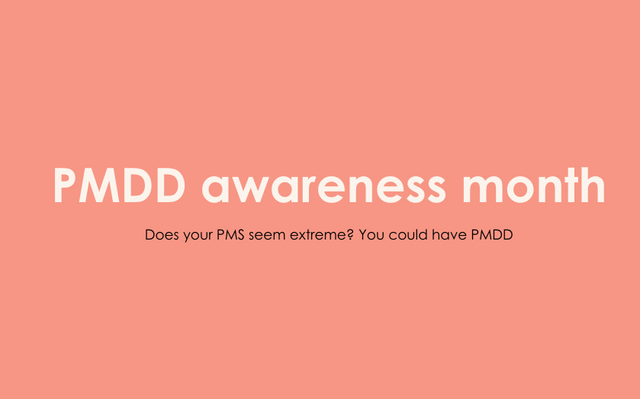Women are used to being told that they are ‘moody’, ‘over-emotional’, ‘cranky’ and ‘crazy’ during menstruation, which doesn’t help. Especially when there are legitimate, hormone-based reasons for mood changes and, in the case of PMDD, much more serious symptoms.
April is PMDD Awareness Month, so let’s shine a light on this debilitating but widely misunderstood (and misdiagnosed) condition.
So, what is PMDD?
Premenstrual Dysphoric Disorder is a hormone-based mood disorder which rears its head during the luteal (pre-menstrual) phase of your menstrual cycle, characterised by severe psychological, and sometimes physical symptoms.
Essentially, it’s your brain having a ‘severe negative reaction’ to changing levels of oestrogen and progesterone during your cycle.
But what sort of symptoms are we talking about? The odd slammed door or teary moment during a soppy TV show?
Not even close. It’s much more serious…and life-changing.
The International Association of Premenstrual Disorders provides the following list of PMDD symptoms:
- Mood/emotional changes (mood swings, feeling suddenly sad or tearful, or increased sensitivity to rejection)
- Irritability, anger, or increased interpersonal conflict
- Depressed mood, feelings of hopelessness, feeling worthless or guilty
- Anxiety, tension, or feelings of being keyed up or on edge
- Decreased interest in usual activities (e.g., work, school, friends, hobbies)
- Difficulty concentrating, focusing, or thinking; brain fog
- Tiredness or low energy
- Changes in appetite, food cravings, overeating, or binge eating
- Hypersomnia (excessive sleepiness) or insomnia (trouble falling or staying asleep)
- Feeling overwhelmed or out of control
- Physical symptoms such as breast tenderness or swelling, joint or muscle pain, bloating or weight gain
Those with PMDD are also at higher risk for suicide, and suicidal thoughts.
How is PMDD diagnosed?
With difficulty. Basically, PMDD is diagnosed by tracking your symptoms every day for several menstrual cycles, and then discussing them with your doctor, with doctors typically looking for the presence of at least five, including one of the first four, to make a definitive diagnosis. PMDD symptoms are usually serious enough to interfere with your daily life at work, school or home.
What causes PMDD?
Research is continuing into the causes of PMDD, and it’s likely it’s caused by a number of factors rather than a single one, however, there is often a genetic component.
Put simply, PMDD is a ‘suspected hormone sensitivity disorder in the brain’, with women with PMDD ‘more sensitive to changes in the sex hormones oestrogen and progesterone’. [1]
Lynda’s experience of PMDD
Lynda Pickett is the Australian Project Coordinator for Vicious Cycle: Making PMDD Visible.
A mother of two young boys, living on the NSW south coast, Lynda is passionate about raising awareness of PMDD so others don’t need to suffer undiagnosed…or alone.
For Lynda, PMDD first appeared when her cycle returned after the birth of her first child.
“I noticed for the first time I was very anxious and extremely irritable in the week leading up to my period. I was having increased conflicts at home, crying uncontrollably for no reason at all and I began having panic attacks the day before my bleed like clockwork. I’d never really had bad PMS before but found it was affecting my ability to parent, causing conflict in my intimate partner relationship and I was unable to return to work, so I sought the help of a GP,” she explained.
“When I first presented with symptoms to my doctor, I felt my experience was somewhat downplayed as being just PMS. When I insisted it was much more intense than that, I was sent for routine blood tests to rule out a hormone imbalance and/or thyroid issues. When those results all came back normal, I was encouraged to consider what in my life could be causing my stress. Was I getting enough sleep? Was I unhappy with my partner? Was I having trouble coping being a new mum? But I knew it wasn’t any of those things. I felt so strongly that my symptoms were caused by hormones that I broke down in tears in the doctor’s office. When my doctor read out the description of PMDD from a medical book, it fit perfectly.”
Lynda later saw a reproductive endocrine specialist and a psychiatrist (to rule out bi-polar disorder), and this input, together with symptom and cycle tracking, led to her official diagnosis with Severe PMDD.
“Diagnosis can be a long process as it sits somewhere between psychiatry and gynaecology and other mimicking conditions need to be ruled out. I was lucky to be diagnosed within the first year of symptoms appearing…the average time to diagnosis in Australia is 8 years!”
What’s the difference between PMS and PMDD?
We asked Lynda to set the record straight on the common confusion between PMS and PMDD.
“Most people (around 80%) who menstruate will encounter PMS. PMDD is much more severe and affects around 5 to 10%. PMS is a normal set of physical and sometimes mild emotional symptoms during the week before your period starts which doesn’t usually disrupt your daily life. PMDD, on the other hand, is characterised by severe, life-impairing emotional (and sometimes physical) symptoms which can last between one and two weeks before your period starts.”
Lynda says it’s not uncommon for PMDD sufferers to be misdiagnosed as bipolar, or having general anxiety or depression, with up to 90% of PMDD patients going undiagnosed.
“A recent study found 30% of respondents living with PMDD had attempted to take their life to escape their severe symptoms, with a much higher percentage experiencing suicidal thoughts and self-harming behaviours,” she added.
How can PMDD be treated?
Lynda lists the current treatment options as natural therapies such as supplementing magnesium, B6 and calcium in your diet, increasing exercise, limiting caffeine and alcohol intake, and following an anti-inflammatory diet.
Medical treatments include oral contraceptive pills containing Drospirenone, such as Yaz or Zoely, hormonal ovarian suppression, SSRI medications or GnRH Treatment (synarel or zoladex), which put you into a chemically-induced, reversible menopause.
The treatment Lynda eventually chose, often considered a last resort, was a Total Hysterectomy with Bilateral Salpingo Oophorectomy (THBSO).
“I was unable to maintain an acceptable quality of life living with PMDD, so opted for a total hysterectomy to remove my uterus, fallopian tubes and ovaries. I no longer have to deal with the rise and fall of hormones sending me into a spin, but being plunged into surgical menopause and balancing HRT (hormone replacement therapy) levels hasn’t been a walk in the park either.”
“This wasn’t a decision I took lightly, and I’d advise people to exhaust all other treatment options before taking such a radical step. Having said that, it has literally saved my life.”
Lynda is hopeful new treatment options will help other sufferers, saying the world’s first-ever PMDD-specific treatment is being clinically trialled with promising results.
“My hope for future generations is that more funding, research and treatment developments will result in PMDD patients being able to manage their symptoms without having to have their reproductive organs removed.”
Is support available for PMDD sufferers?
Thankfully, YES.
“I don’t know where I would be without my fellow PMDD peeps. If you use the hashtag #pmddpeeps on Instagram or Twitter you’ll quickly find others to connect with, such as a huge facebook support community which includes closed peer support groups in most countries for sufferers, their partners, people with and without children – the lot. For me, the best thing about this kind of support is that you’re talking to people who genuinely understand what you’re going through.”
Organisations where sufferers can seek support include:
Vicious Cycle: Making PMDD Visible
A patient-led project passionate about raising awareness of PMDD and improving the standards of care for people living with the condition.
The International Association of Premenstrual Disorders (IAPMD)
A global charity working to inspire hope and end suffering for those affected by premenstrual disorders through peer support, education, research and advocacy. Check out the self-screening test: https://iapmd.org/self-screen
Me V PMDD
PMDD symptom tracking app.
If you have symptoms or want to know more, please reach out to your doctor or health professional.







